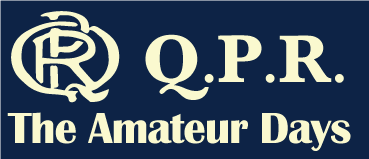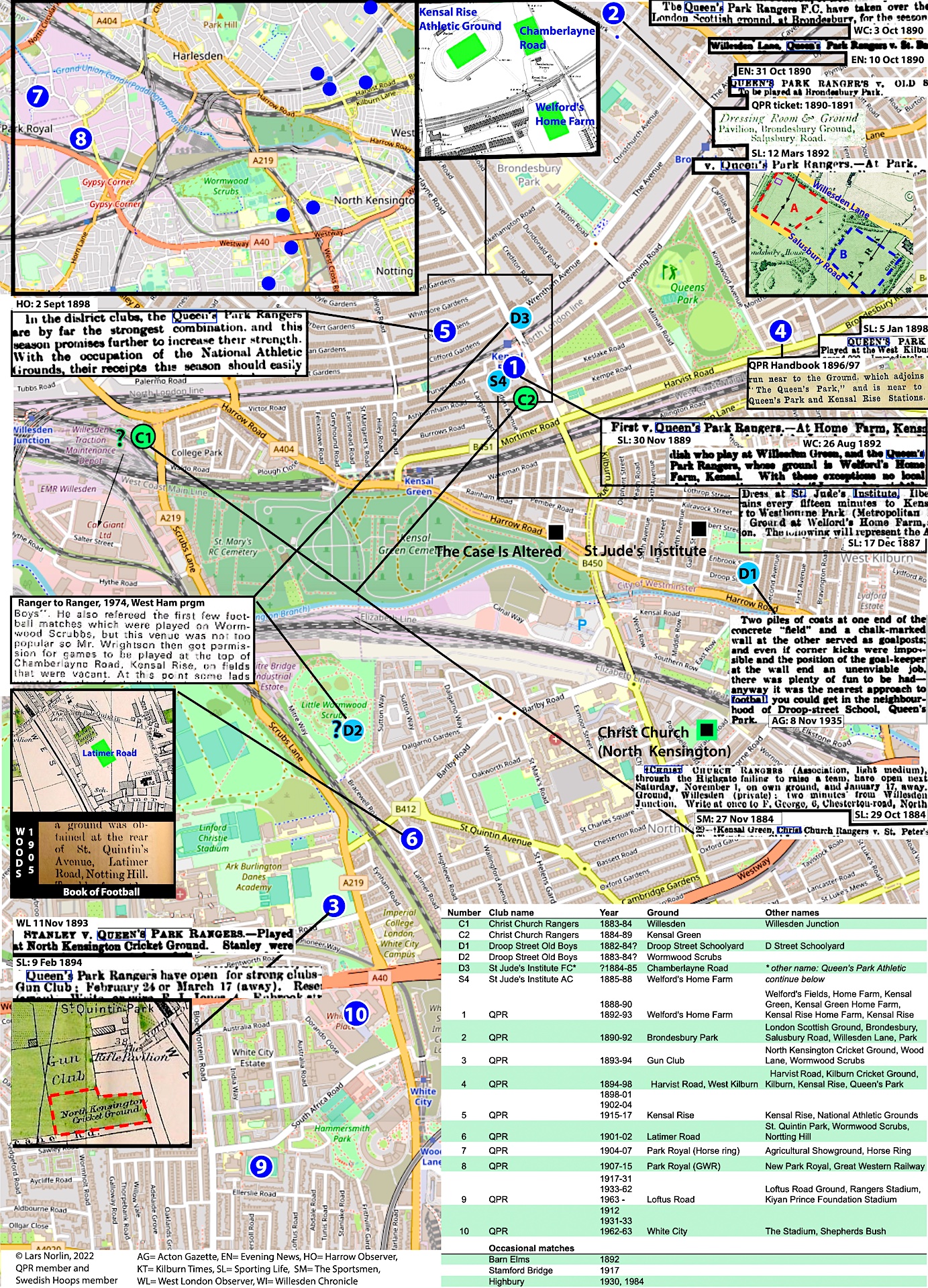| Football grounds during the 19th century. New knowledge. |
The early football clubs had trouble finding good grounds for football. It was then as now fierce competition about land: from other football clubs, other sports but above all it was the fast growing London needed land for housing, industries and infrastructure. Often the grounds came to lie on the outskirts of the residential areas on the borderland between the city and the countryside. The field the club could hire was often not very suitable for football matches. It could be rough, slant, irregular but the most common problem it became often waterlogged, especially in the winter.
|
| Naming of grounds, newspapers |
The 19th century naming of grounds was almost always a description of the location of the ground. How to get there. The most common name is the road that is adjacent to the grounds pavilion or the road that leads to the ground. The name could also been taken from the area, the parish, the estate or a park name, if the ground was located in a park. Slightly uncommon, the name was taken from a house, pub or o pavilion, but it does occur. Sometimes the field had a well-established name who continue to live on, such as “Spotted Dog” in east London.
In my research, I have found the names are often given after the nearest train station. it's quite common for a ground to have several different names at the same time. A well-known modern example is West Ham United's previous ground. It was at the same time called: Upton Park, Green Street and Boleyn Ground.
During the 19th centuary, the names were mostly aimed for the club,it's members and supporters. When the away team wrote notices about a game they often used, as a ground name, the name of the station where the away team got off the train. Especially in London it could differ from the station used by home supporters as there are several stations near the ground.
The official name should be the name given in addresses, fixture cards and in the annual Handbook which is a kind of annual official document. But it’s difficult to find out the name. Often these documents only describes which road the grounds pavilion is located to. The addresses for the club used to be the home address for the club secretary.
|
| Matches |
In the early 1880s, almost all matches consisted of friendly matches. During the 1890s, a lot of cups and then league matches were added.
The matches were usually decided before the season started when the team settle a fixture card. These were sent to the newspapers and perhaps also supporters. During the season, there were changes, moves and canceled matches. The clubs advertised for new opponents when they had spare time and indicated what type of resistance they were looking for: a light, medium or strong team.
When I worked with this history, I found out the game order: home teams - away teams is not always correct in the 19th century world. For cup matches, there was a rule that teams that stood first had to choose whether they wanted to play on their own field or on the away team's field. It could be an advantage for a team to play on the away field, especially if your own field was worse and you had a more skilled team. It also seems to have applied to other matches as there are quite a few "home matches" that are played on the away team's field. Below the result of Queens Park Rangers - Kensington Rangers, played at Barn Elms which were the home ground for Kensington Rangers. At that time QPR played at Brondesbury Park.
It should also be noted that the reserve teame sometimes played their home games on other venues than the teams home ground.
|
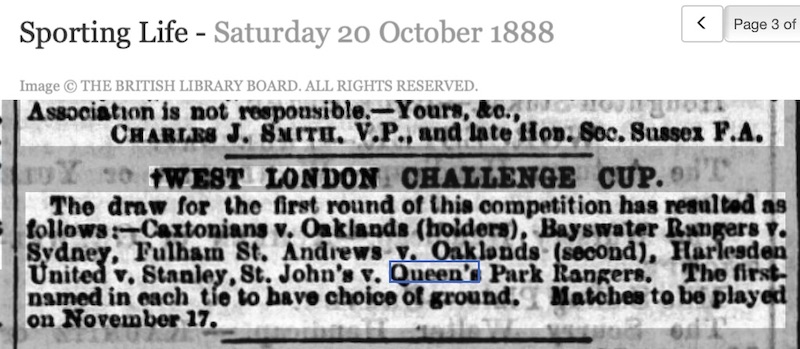
Fig 2. The first named in each tie to have choise of ground
|
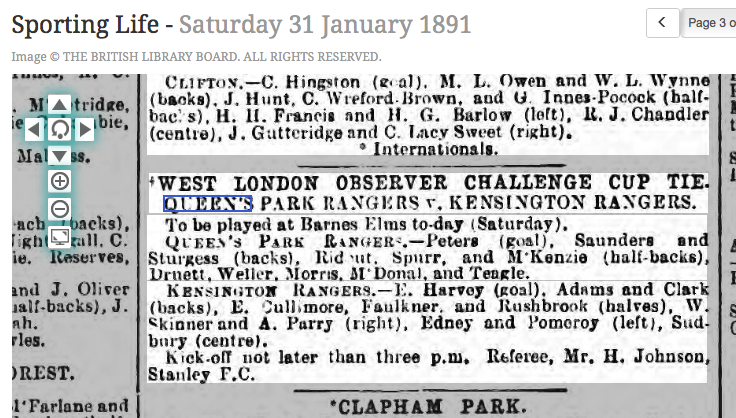
Fig 3. Barnes Elms was Kensington Rangers home. This ground was probarly a better choice for QPR than their home Brondesbury Park.
|
<| Summary New Findings |
- In cup tournaments, first named teams were allowed to decide on which ground the match would be played; home or away teams ground.
- In other matches, it was also very common to have pitch changes. Sometimes they look for third-hand choice of grounds. The announced order of the team was not changed. This means that there can be misunderstandings about which teams grounds a team has used.
- Away and home teams have different names on grounds. In London it is common for away teams to use the name of the railway station they disembark at. QPR's away teams have used the names: Willesden, Kensal Rise, Queen's Park, St Quintin's Park.
|
|
| Discussion and Conclusions for each QPR ground |
| Names of the ground used in the headlines of this sector is taken from the oldest history in the handbook 1899 or the most used in contemporary newspapers. |
| Source's, naming of grounds and years |
Droop Street Old Boys: QPR history 1899,
St Jude's Institute: QPR history 1899, Newspaper
Christ Church Rangers: Newspapers, Hayter QPR history 1948.
Welford Home Farm: Newspapers and QPR history 1899, QPR history 1905 (Woods).
All other grounds: Newspapers from actually day when notices about QPR games were puplished.
|
| Droop Street Old Boys.The time before the St Jude's Institute and QPR,1882-1885 |
According to QPR History in 1899, the club Droop Street Old Boys was founded in 1882 by former pupils from Droop Street Board School. From the beginning, the school yard was used as a football field. Two piles of cotes at one end of the concrete "field" and a chalk-marked wall at the other served as goalpostsl (50 years of Football, Bushranger, Acton Gazette 1935). This early club was a youth club where the charismatic teacher Johnny Wrightson had helped with the formation and acquisition of football grounds. He was also called the true founder of QPR when he left as a teacher in the first decade of the 20th centuary.
After school yard, the club played on a field in Wormwood Scrubs but it was not good one and the club moved to a field at the end of Chamberlayne Road, just north of the current Kensal Rise Station. To make the club more efficient Johnny Wrightson contact vicar Sydney Bollt at St Judes Church and the club became under the church protection and changed its name to St Judes Institute.
|
| Christ Church Rangers 1883 - 1889, later Paddington 1890-1905? |
In official history, Queen's Park Rangers are the result of the 1886 merger between the St. Jude's Institute and Christ Church Rangers (CCR). It’s possible to question, both the year and the nature of the merger, as the name QPR is not used until 1888 and Christ Church Rangers continues to operate after 1886 with the same players after as before. But some kind of merger has taken place. The name Rangers is almost certain taken from Christ Church Rangers More in the Christ Church Rangers and Complicated Merger chapters.
Christ Church Rangers first played (1883-84) on a field 200 yards from Willesden Junction, perhaps east of the station at the top of the current Scrubs Lane on the west side. Thereafter from 1884 Kensal Green is named as the ground. There have been a lot of clubs playing at Kensal Green, even QPR, but in that case you can be sure that the ground is called Welford's Home Farm. CCR's field has probably been close to QPR's ground.
The pub "The Case is Altered" at Harrow Road is mentioned in Hayter's QPR history from 1948. He writes that QPR's players changed clothes at the pub. Hayter's main source is club director Wodehouse Junior who retells his father's story. Wodehouse Sr. had been a player in both CCR and QPR. But QPR changed clothes at St Judes Institute. The pub may have been used by the CCR and its ground may have been closer to the pub.

Fig 4.
|
| Welford's Home Farm, St Judes Institute 1885-88. |
Vicar Sydney Bott acquired a field owned by Welford's Diary. The milk producers had three farms in the immediate area: College Farm, Haycroft farm and Home Farm. The field the club rented was near Home Farm, as the name was Welford's Home Form. This name is confirmed in several independent sources: QPR history 1899, Bushranger QPR history 1935 and several newspapers 1887-1892. A later name for the ground Welfords Fieds first appears in Wood's history from 1905. Wood's history is more detailed than the history from 1899 but gives some deviating information for the very oldest history. The facts for the 1899 history was compiled by a group older football player led by H. G. Teagle. All of them had played on Welford's Home Farm and most of them had grew up in Queen's Park, which makes his facts more credible. Woods also used the Welford’s Farm name in an program interview 1920 in his 18/4/1921 Testimonial Match QPR - Chelsea 1-0. “his first knowledges of the Rangers, was when as a boy, he used to climb over the fence of Welford’s Farm (Kensal Green) to watch them in their early Amateur days in 1889.”
|
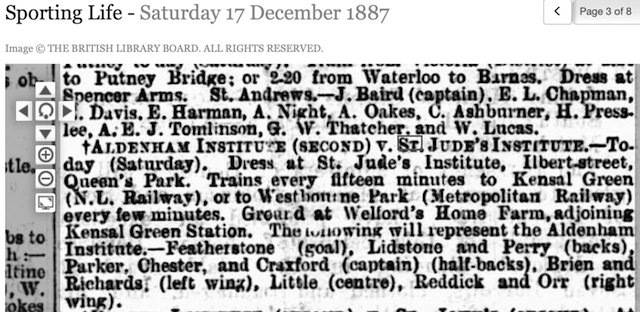
Fig 5.
|
|
| Welford's Home Farm, Queen's Park Rangers: 1888-90, 1892-93. |
| The name of the ground |
Welfords Home Farm has been used in two time periods 1887-1890 and 1892-1893. In traditional history, 2 to 3 names have been mistakenly used for the ground. Most common is Welfords Fields (1887-1890) and Home Farm 1892. This inaccuracy comes from Club Secretary Wood's history from 1905. Despite the fact that he calls the ground Welfords Farm in the programme from 1921 when he was retired after served as Club Secretary 1902-1921.
Below the names used during the two periods and in total:
- Welfords Home Farm 1 + 1 = 2
- Queen’s Park 3 + 1 = 4
- Kensal Green 4 + 0 = 4
- Kensal Rise 0 + 9 = 9
- Home Farm, Kensal Green 1 + 0 = 1
- Home Farm , Kensal Rise 0 + 1 = 1
- Home Farm 1 + 0 = 1
- Willesden 1 + = 0 = 1
Most common name with variants:
Kensal Green is the name of the nearest station. The station was renamed 1890 to Kensal Rise.
Kensal Green later Kensal Rise: 4+9 = 13
Welfords Home Farm: 2+1+1+1 = 5
The name Willesden was used by the Acton team who proparley used to get off at Willesden railway station.
The name Queen's Park refers to the Queen's Park Estate or Queen's Park railway station
|
| The location of the ground |
The location is adjoining Kensal Green Station (Kensal Rise after 1890) (Sporting Life 17/12 1887). It is also south of the station according to Woods history 1905.
|
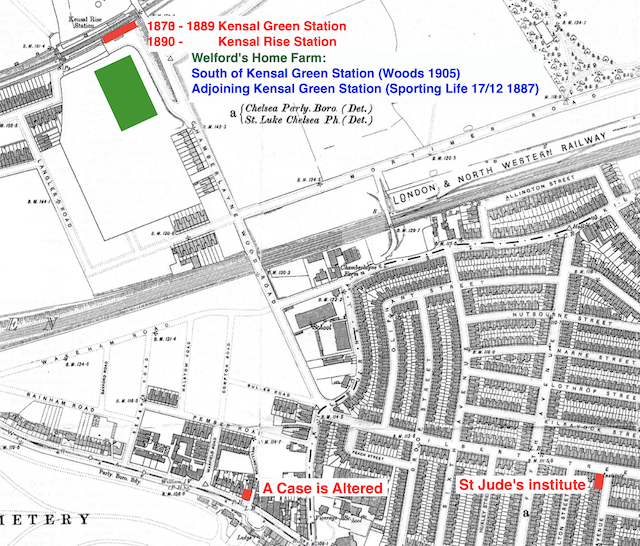
Fig 6. Version 1 - 2022-09.
|
| Brondesbury Park 1890-1892 |
Brondesbury Park was the clubs ground in two seasons. 1890-1891 and 1891-1892.The ground became too waterlogged in the vinter of 1892 it has to play the rest of the seson in opponents grounds.
|
| The name of the ground |
Below the names used during the two periods and in total:
- London Scottish Ground 1
- Brondesbury Park 16
- Brondesbury 4
- Salusbury Lane 1
- Willesden Lane 1
- Willesden 2
- Park 1
Name given in the club Handbook 1899 by the players: London Scottish Ground in Brondesbury.
Brondesbury Park was the common name used in the newspapers and is a more descriptive name.
Willesden Lane is the first name used. Park the last name used.
|
| The location of the ground |
Brondesbury Park Ground first appears as Willesden Lane in October 1890 and in a 1891 ticket has the address Salusbury Road. At that time Salusbury Road was extended through Brondesbury Park. The upper part of the road changed name to Brondesbury Park ca 1892. The conclusion is that the ground is between those roads. Brondesbury Ground is also called “Park” only. Conclusion: the ground is in the park between the roads and then there are two possible fields as location for the ground.
The location A in fig 7 is more likely. The location B is near the church, which is less likely. In the location A there is also a building that can be the pavilion mentioned in QPR's ticket from 1891.
Today, photo 2022 fig 9 below was taken at the place of the the pavilion, red square on the map in fig 7. Nowdays it’s the place of Bramerton house. The western border of location A is a large hedge with old border posts, the same hedge as in the map. This is also opposite of the Mapesbury House (demolished 1925) on the other side of Willesden Lane.
|
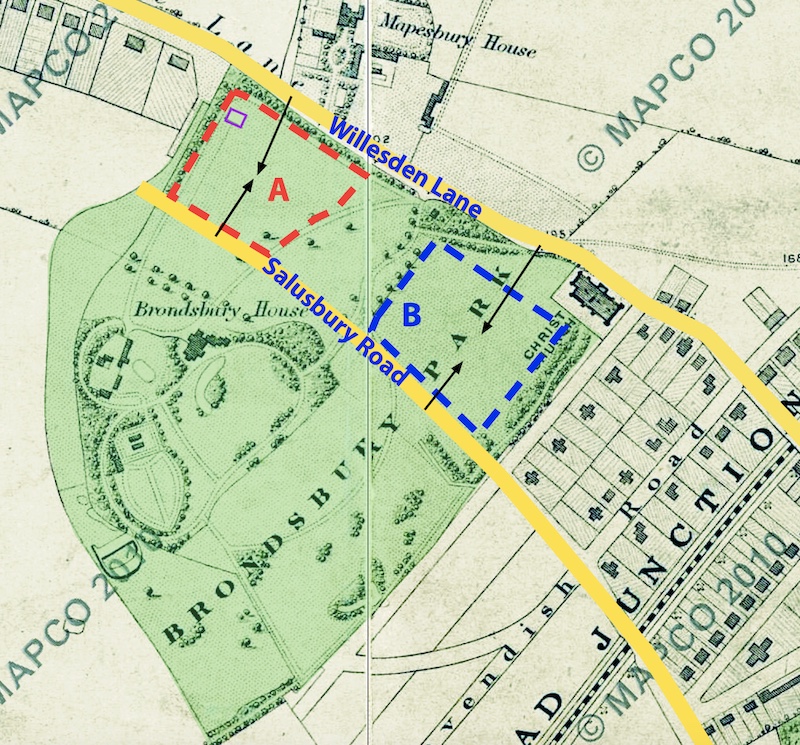
Fig 7. Two possible location A or B. A is more likely. There is a pavillion there and B is close to the church.
|
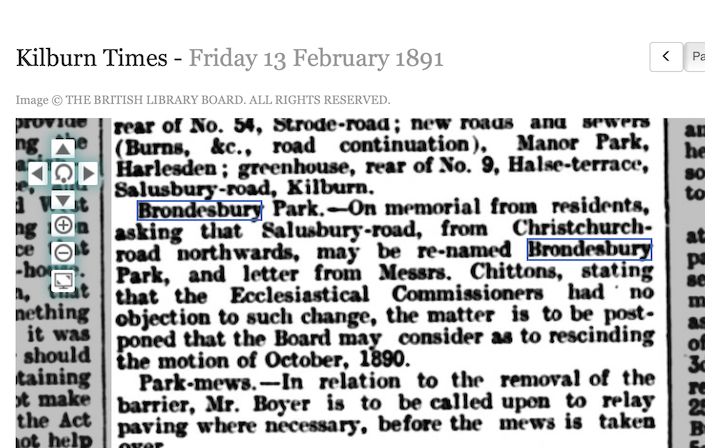
Fig 8. Salusbury Road name change.
|
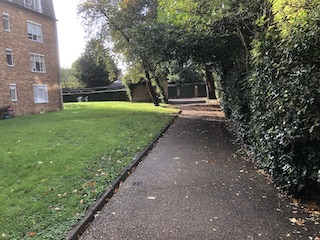
Fig 9. The Hedge was the northwest border of location A. Photo at the place of the pavillion.
|
|
|
| Gun Club 1893-1894 |
“Gun Club” is the name of the ground, when the club is advertising after matches in February 1894.
|
| The name of the ground |
Below the names used and number of times in the newspapers:
- Wood Lane 1
- Wormwood Scrubs 7
- Scrubs 1
- North Kensington Cricket Ground 2
- Gun Club 1
Name given in the club Handbook 1899 by the players and when the club is is advertising after matches in February 1894: Gun Club at Wormwoods Scrubs.
Wormwood Scrubs was the most common name in the newspapers. But the Handbook 1899 name Gun Club is a more distinct name.
|
| The location of the ground |
|
It is also called “North Kensington Cricket Ground”, “Wood Lane” and “Wormwood Scrubs”. Above the field is the park Wormwood Scrubs, the shooting club had the shooting ranges there. On general maps, the Gun Club is marked at the location of the shooting ranges, at the height of the current Linford Christie Stadium, but the fields for football and cricket were at Du Cane Road. The North Kensington Cricket Ground is the most likely the field. The Pavillion hotel is also nearby.
|
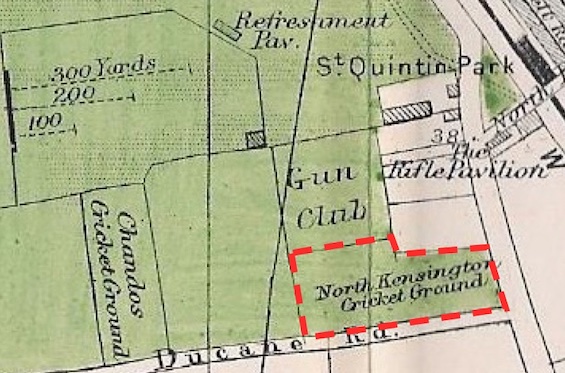
Fig 10. Map from ca 1900
|

Fig 11. Map from late 1890s to 1892.
|
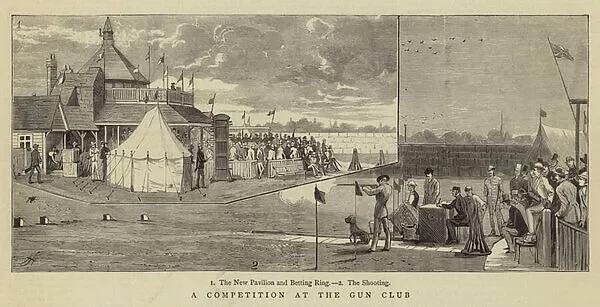
Fig 12. Gun Club. The Shooting range appears to be near the Rifle Pavillion?
|
| Harvist Road, West Kilburn 1894-1898 |
|
Harvist Road, West Kilburn or Kilburn Cricket Ground was a ground first used by Kilburn Cricket Club. Their old site was at Ashmore Road until 1893. When the area was built up the Kilburn CC moved to a new site beside the park “Queens Park” Fig 13.
|
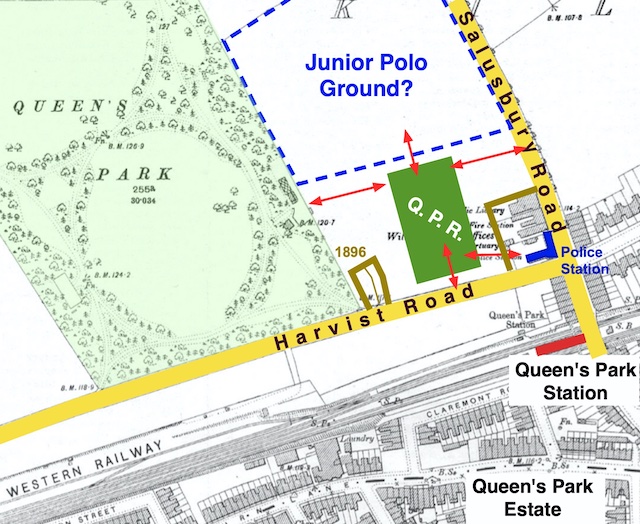
Fig 13. The location is between Salusbury Road, Queen's Park and Harvist Road. Two houses were for sale 1896, Havrvist Road 18 and 20. The settlement crept closer and Rangers left the ground 1898 and moved to Kensal Rise.
|
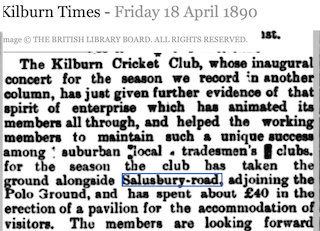
Fig 14.
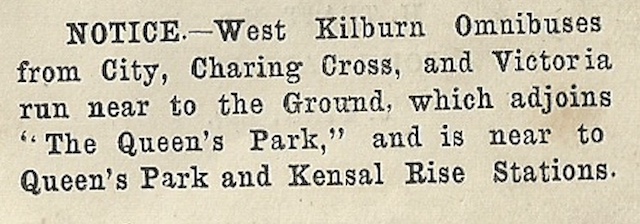
Fig 15.
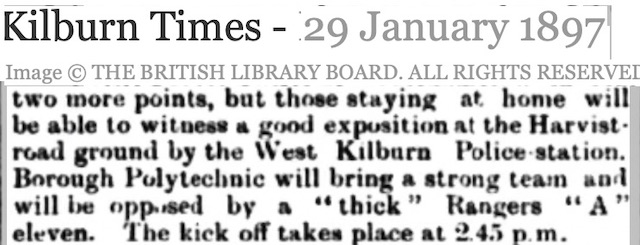
Fig 16.
|
| The name of the ground |
The newspapers notices between September 1894 to April 1898 gives the following names /location for the ground:
- Kilburn Cricket Ground 1
- Kilburn 4
- West Kilburn 27
- Queen’s Park 2
- Queen’s Park, West Kilburn 1
- Paddington Green (probably another ground) 1
- Harvist Road 7
- Harvist Road, West Kilburn 7
- Kensal Rise 2
This is not complete research
The two most common names are West Kilburn and Harvist Road. The most distinct name is Harvist Road. West Kilburn is a wider area. Both names is a adress names, and appears combined as Harvist Road, West Kilburn in the oldest historics from 1899 and from handbooks from the years the Rangers played in the ground. This should be the most correct name.
|
| The location of the ground |
By combining several different newspaper notices, the location becomes completely clear. Fig 13-16.
- Near Salusbury Road and near Kilburn Polo Ground. Fig 13 and Fig 14. Kilburn Cricket Club Ground started the ground.
- Adjojning the park ”Queens Park” and the address is Harvist Road. QPR Handbook 1897. Fig 13 and Fig 15.
- Near Kilburn Police Station. Fig 13 and Fig 16.
|
| Kensal Rise Athletic Stadium 1898-1901, 1902-1904, 1915-1917 |
Rangers played at the ground during three spells.
The ground had four names used at the same time:
National Athletic Grounds = official name
Kensal Rise Athletic Grounds = proper name
Kensal Rise = common name
The Rise = short common name. Used last spell 1915-1917
Before ca 1898 the ground is called National Athletics Grounds and was used för bigger matches such as semi- final, finals of regional cups. QPR hired the ground at three times. At the last spell the ground was often called just "The Rise".
Below is a rectified map with a layer from 1890 on a layer with todays map. |
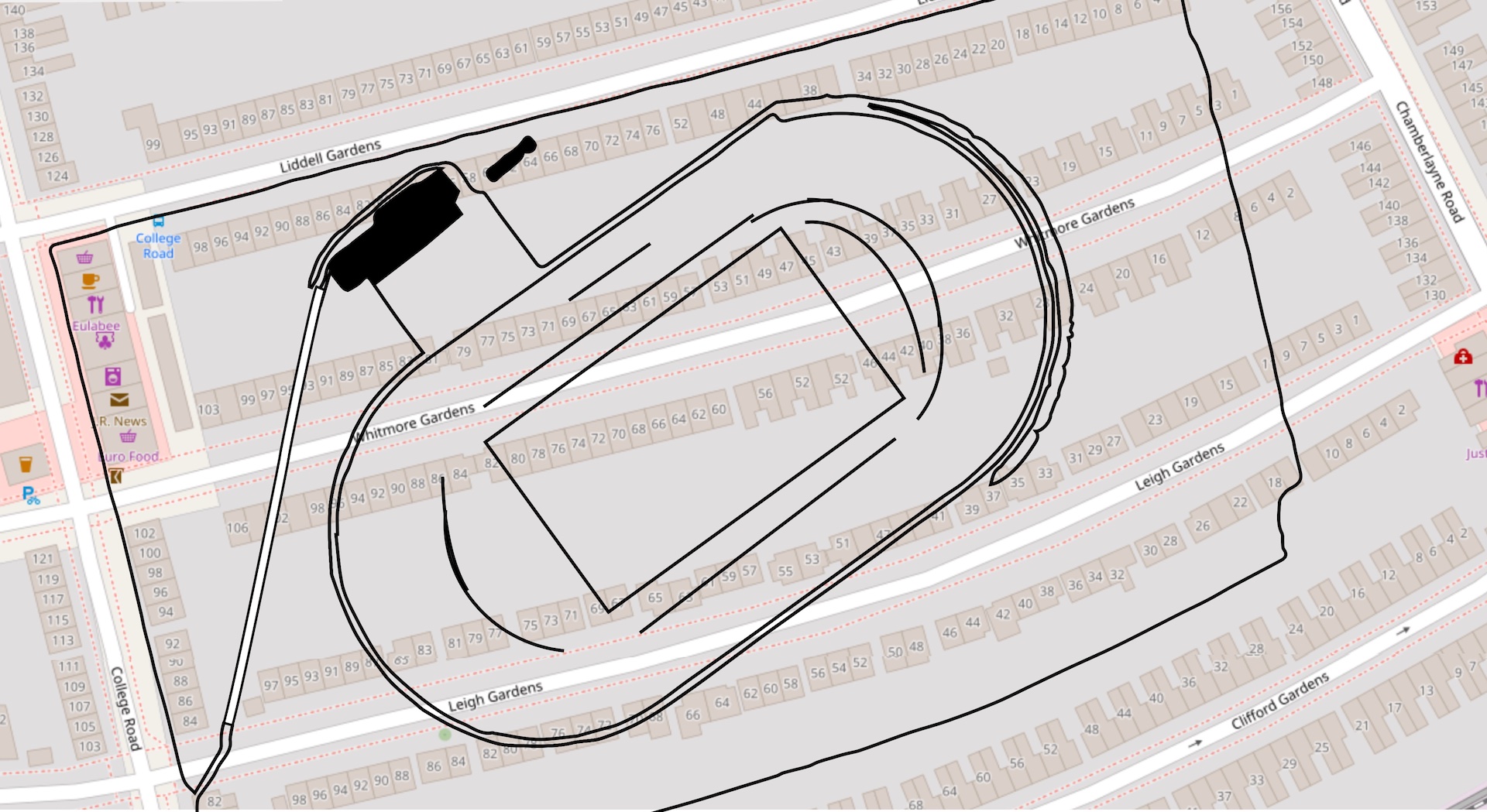
Fig 17. This rectified map consists of 2 layers. Background map in color and oa drawn black-white map of the Kensal Rise Ground. This is from the 1914 Ordnance Survey Map of Kensal Green and Queen's Park. From the map you can roughly see the extent of the ground. The eastern goal should be between 47 and 52 Whithmore Garden.
|
| Latimer Road 1901-1902 |
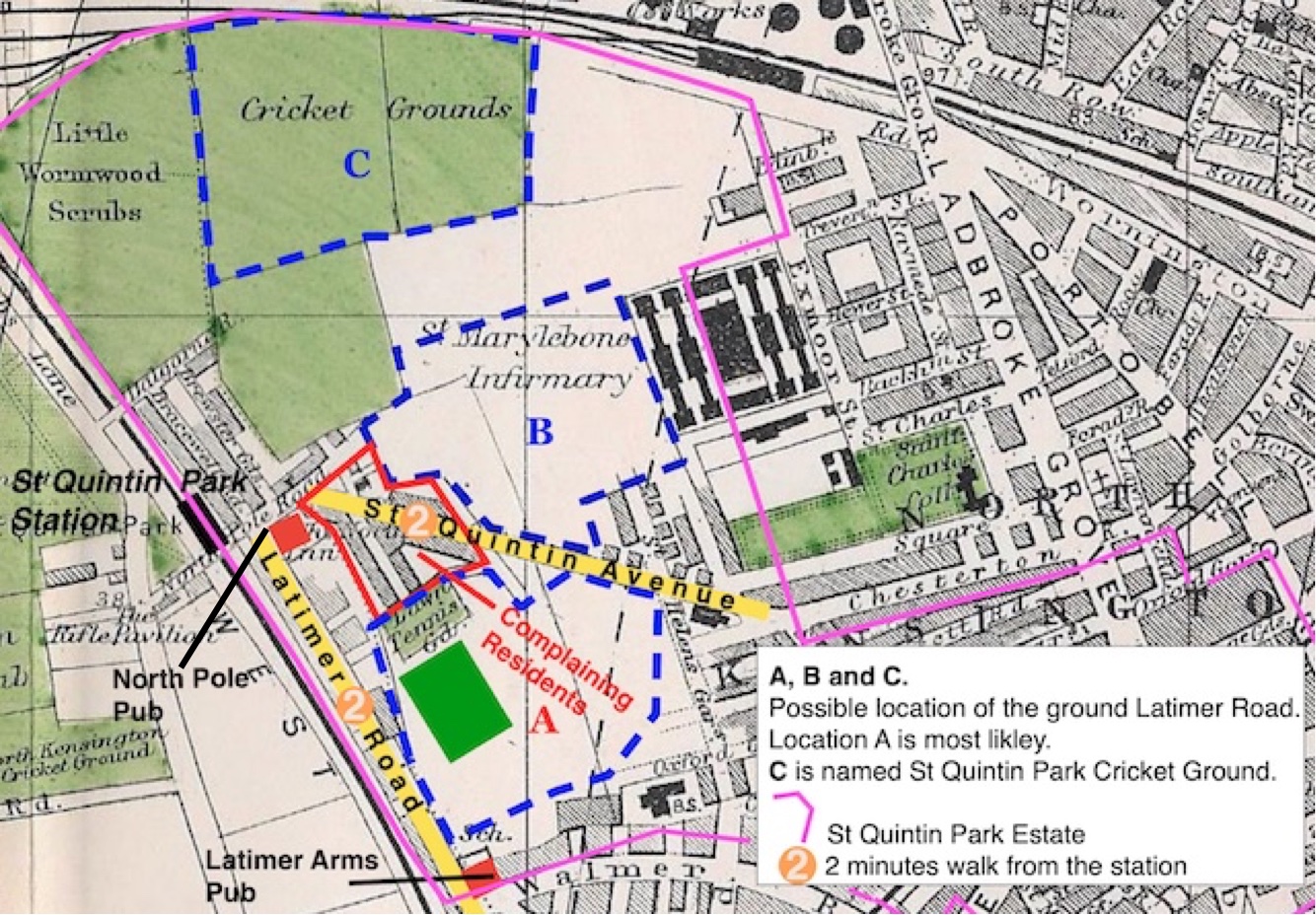
Fig 18. The two pubs was used as dreessing room. There is information about dressing room was planned to be built at the main stand but it was not ready forst the first game /games?.
|
Rangers played at Latimer Road one season 1901-1902. They returned to Kensal Rise Athletic Ground next season.
There are two questions that need to be investigated. The name of the ground and where it was located.
Over the years the ground has been called both Latimer Road and St Quentin Avenue and the location has shifted between being at Latimer Road (A on the map - Fig 18) or St Quintin Avenue (B on the map -Fig 18).
1905, Woods - a ground was obtained at the rear of St Quintin’s Avenue and Latimer Road.
1906, the Mate, Athletic News - of a ground in Latimer Road, Notting Hill.
1921, Unite Jones, All Sports Weekly. - Named:St Quintin Avenue. ...a fairly good ground was found behind St Quintin’s Avenue, Notting Hill.
1948, Hayter - a new ground was obtained at the rear of St Quintin’s Avenue and Latimer Road.
1969, Signy - same as Hayter / Wood
1976, Buxton - same as Hayter /Wood
1990, Shaoul - Named : St Quintin Avenue. They moved south to St Quintin’s Avenue off Latimer Road in Notting Hill.
2000, Macey - a ground was obtained at the rear of St Quintin’s Avenue, near Latimer Road
2009, Macey - Named: Latimer Road. at Latimer Road, near St Quintin’s Avenue
2013, Incenzo, Macey? - Named: Latimer Road. Exact location is not detected
The Name:
The most reliable source is to go through contemporary newspapers during the 1901-1902 season. It took time so I limited the research to two months and 19 newsclip: September - October 1901 with the following results, name, number of times:
Latimer Road 12
Latimer Road ground 2
Latimer Road, St Quintin’s Park 1
St Quintin’s Park 1
St Quintin Avenue 0
near Wormwood Scrubs 2
Notting Hill 1
Total Latimer Road named 15 times ca 80%. The other name suggested: St Quintin Avenue, has never been used as name for the ground.
Case closed. The name of the ground was Latimer Road. Fig 19.
The location:
First source:
The oldiest description of the location is from Club Secretary W. L. Woods history from 1905, 3 years after QPR played there:
”a ground was obtained at the rear of St Quintin’s Avenue and Latimer Road.”
For me it will be the behind both streets, the empty field between Latimer Road and St Quintin Avenue, A on the map above,Fig 18. In recent years, but also in the history of the 1920s, there is interpretation that the ground was behind St Quintin Avenue. About where the Kensington Memorial Park is now located.
Second source:
A clue as to where the ground may have been can be found in Hayter's history from 1948:
”… there the players changed in the ”Latimer Armes” and to the delight of small boys who could not to afford to pay the penny admission, their heroes ran along the road to and from the pitch.”
The only possible road from Latimer Arms to the ground is Latimer Road and the ground locaton A on the map. There is no road from Latimer Arms to St Quintin Avenue. Fig 18 above.
Third source:
The name of the ground was Latimer Road. Had the ground been near St Quintin Avenue the name could possible not been Latimer Road. The purpose to have a raod name for the ground is for spectattors and others have easaly to found the ground. Road name in early days was often the place near a pavillion or the main stand or the clubs office. Fig 19.
Fourth source:
In the clip from 10 september 1901 there is stated the ground is within two minutes walk from the railway staion.The green football pitch inthe map, Fig 18 is reached within two minutes walk. The field above St Quintin Road is well ahead of two miniues walking. Fig 18.
All four sources iclearly favor of a ground at location A in the map,Fig 20. It could been somewhere inside the red dotted area. But the sources make it also very cear that the most possible location is the green rectangle. The ground could had been facing purpendicualry.
Location B. This is far from complete data (coming eventually), but still shows that Latimer Road is by far the most frequent name. St Quintin Park is used by the opposition team's newspapers and then also supporters. It is the name of the nearest railway station.
Location C, the cricket pitch was called St Quintin Park Cricket Ground. Football Amateur Club: St Johns (Notting Hill) played at St Quintin's Park.
This means that location A on the map is the only possible. Location B has previously been suggested, mainly because the name St Quintin Park is written over the area on older maps, for example on the Ordnance Survey Map from 1914. But the name St Quintin Park does not refer to a park but to an estate as on my map drawn with a pink line. All 3 locations are within the St Quintin Park Estate. Location C is marked at the cricket pitches which are also called St Quintin Park Cricket Ground which makes the same name impossible for location B. Location C is too far away from Latimer Road to be relevant.
|
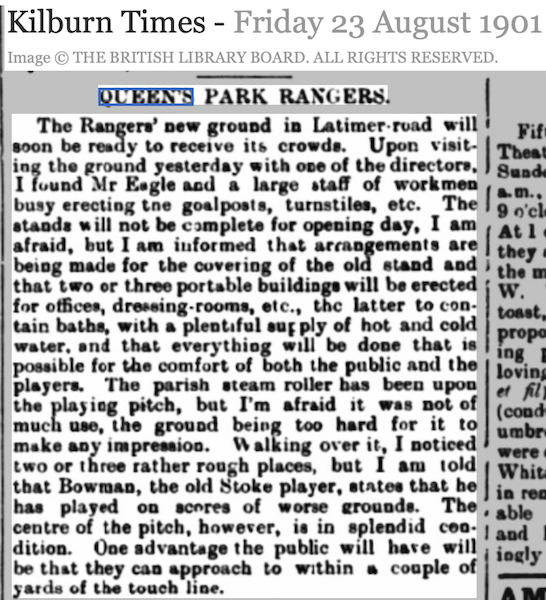
Fig 19. First info of the new ground.
|
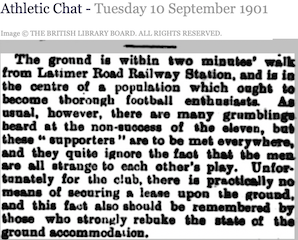
Fig 20.Two minutes walk.
|
|
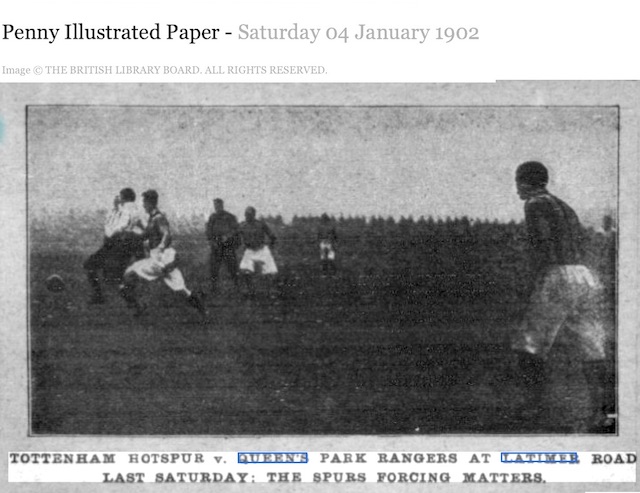
Fig 21. This could be to the east and St Quintin Avenue. People standing on a bank.
|

Fig 22. This could be a stand to the west and Latimer Road. There could be some housing behind the stand att the right.
|
| |
|
| Park Royal 1904-1907 (first ground) |
In their pursuit of grounds, QPR ended up at Park Royal 2 miles from Queens Park. This ground had been laid out by the Royal Agriculture Society and was called the Horse Ring, named probably after it’s role as exhibition stadium for horse activities. QPR came to call it Park Royal after the area. The location is marked on a map by the Brent Historical Society. The name Park Royal comes from the Royal Agriculture Society's Showground, which had opened in 1903. It was at Park Royal that QPR first came to play in hooped shirts. When the Rangers made a decisive change of grounds, they also made major changes to the jerseys as well.
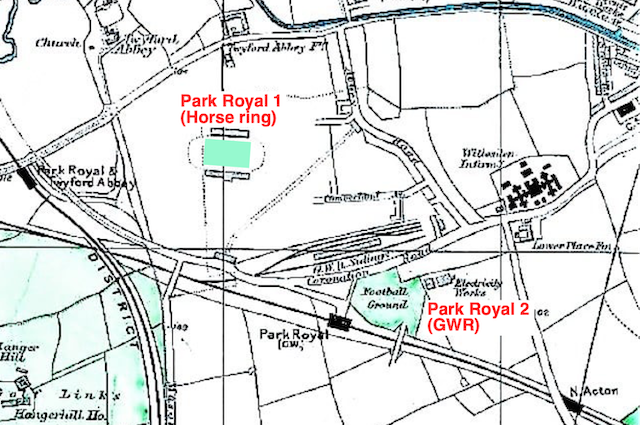
Fig 23. The two Park Royal grounds
|
| Park Royal 1907-1915 (second ground) |
| The Royal Agriculture Societys sold its showground in 1907, which meant moving again for QPR. Timely enough, Great Western Railway then had a completely newly built arena with a capacity for 60,000 spectators. It was built nearby the company's railways, probably with the intention of transporting QPR's supporters. The arena also came to be known as the Park Royal. But in the beginning, the arena was called the New Park Royal. The Park Royal also housed the Guinness factory at the spot at the former ground the Horse Ring. Both GWR and Guinness factory workers were QPR supporters. In February 1915, the ground was taken over by the military and QPR's moving cargo returned to Kensal Rise. |

Fig 24. Park Royal drawing is layed upon present map.The Park Royal Ground was located where Coronation Road meets the railway. Sovereign Park runs now through the old arena. To the east, the road to generation station coincides with the present Britannia Way. To the south is now Johnson Way, which is called Station Approach in the drawing. There seems to be some remnant of Park Royal Station.
|
| White City 1912, 1931-1933, 1962-1963 |
White City was first called the Stadium, Shepherds Bush. The arena was built as part of the Franco-British Exhibition. The seating capacity was as many as 68,000 spectators. The first time the club used the arena was Long Good Friday 2012 during a train strike. Few matches were played and no other entertainment was allowed so the club had expected a large number of spectators but not the huge 62,000 spectators, which is the club's attendances record.
Link to 62,000 at the Stadium 1912 (open in a new window).
|
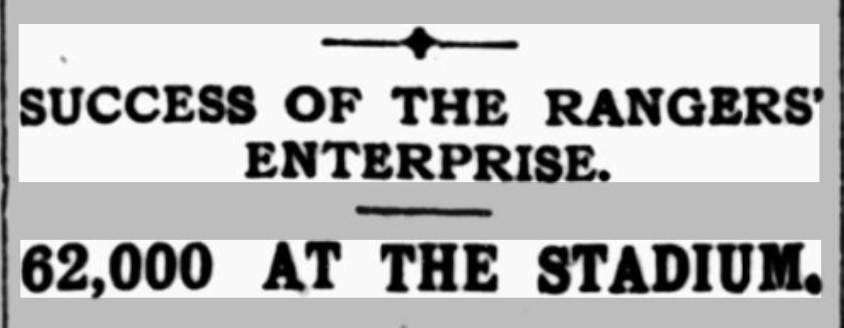
Fig 25. Record attendances in White City.
|
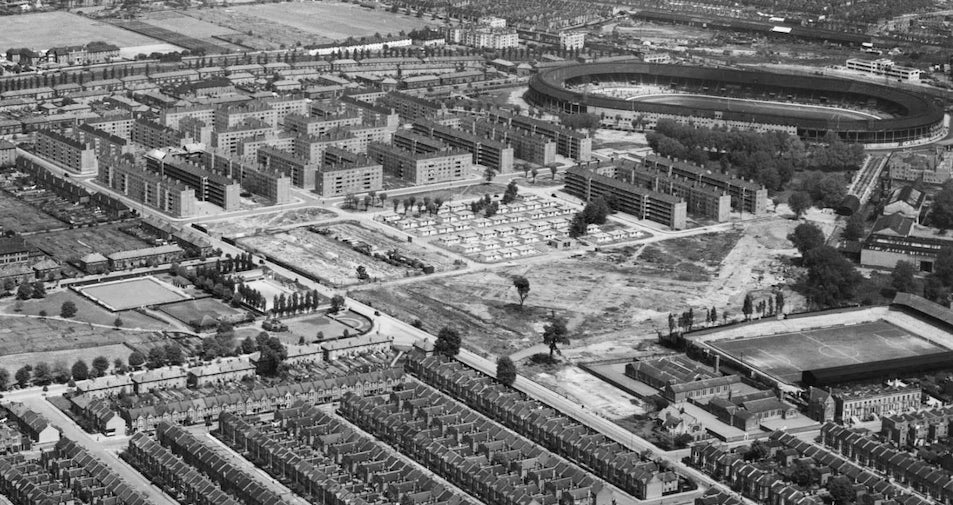
Fig 26. Loftus Road and White City.
|
| Loftus Road 1917-1931, 1933-1962, 1963- |
The field at the end of Loftus Road was during the late 19th centuary a typical area between buildings and agriculture. Nearby was Wormholt Farm, which had leased several fields to football clubs such as Shepherd's Bush, Hammersmith, Kensington and Westminster.
Old St Stephens was originally from Westminster and 1905 the club changed its name to Shepherd's Bush FC and leased the field at the end of Loftus Road. During the First World War in 1915, the club ceased to exist and QPR leased the ground 1917. When the Central Railway (Central Line) was built for Shepherd's Bush, the field at Loftus Road was used as landfill, and later when the field became a football pitch, the clay layers made the pitch easily waterlogged.
|
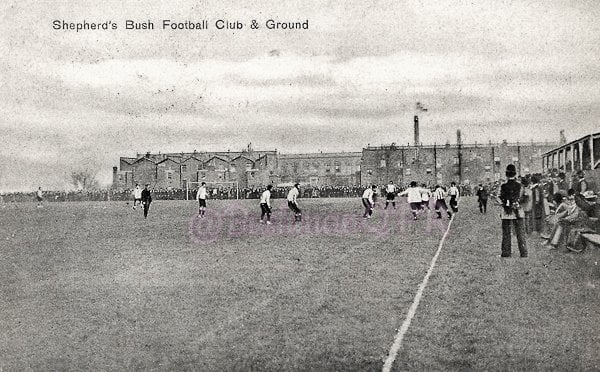
Fig 27. Loftus Road in the days of Shepherds Bush FC.
|
| Herbert George Teagle and the 1899 QPR history |
Teagle became the club's second team captain 1893 when he succeeded the club's initiator and first team captain John Mcdonald. Teagle was captain until 1897. He was also occasionally the club's secretary.
When the club wrote its first history in 1899, it was Teagle together with Hiscox, McKenzie and Webb (Ward?) who compiled the facts to the history. Teagle was born and raised in Queens Park, married to a sister of Henry Spurr who was already a player on the schoolyard. Henry Spurr was also the club's chairman when the history was published. This history has high credibility in terms of grounds and the oldest history as it was made by players who played on these grounds.
|
| Paddington Recreation Ground |
QPR have played on all the grounds available in north-west London with one exception: Paddington Recretaion Ground. This arena was established as early as 1888 by Paddington borough. Several Paddington clubs have played there, including Paddington FC and Paddington Town FC. But it could have been QPR's ground in the early 20th century. The club placed a bid in 1904? to rent the ground. The club had the highest bid, but the Borough didn't think the area was suitable for a professional club.
|
